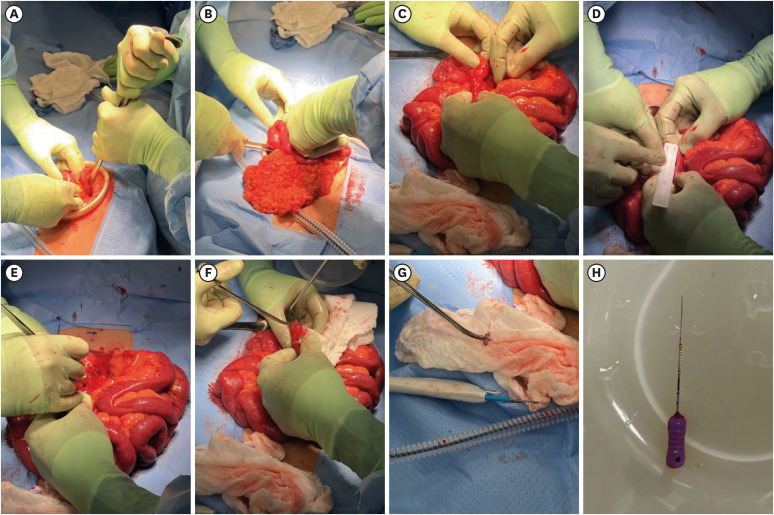Restor Dent Endod.
2023 Nov;48(4):e32. 10.5395/rde.2023.48.e32.
Ingestion and surgical retrieval of an endodontic file: a case report
- Affiliations
-
- 1Department of Endodontics, Tufts University School of Dental Medicine, Boston, MA, USA
- 2Brown Surgical Associates, Inc., Newport, RI, USA
- 3Warren Alpert Medical School of Brown University, Providence, RI, USA
- KMID: 2548753
- DOI: http://doi.org/10.5395/rde.2023.48.e32
Abstract
- Ingestions and aspirations of foreign bodies are rare, but do occasionally occur during dental treatment. Although reports exist, few include photos demonstrating the extensive surgical intervention that may be necessary to manage such events. Perhaps this lack of visualization, and associated lack of awareness, is one of the reasons some clinicians still provide nonsurgical root canal therapy (NSRCT) without a rubber dam. This case report outlines the medical treatment of a 30-year-old male who initially presented to a general dentist’s office (not associated with the authors) for NSRCT of their mandibular right first molar. A rubber dam was not used for this procedure, during which the accidental ingestion of an endodontic K-file occurred. The patient was subsequently hospitalized for evaluation and treatment, consisting of numerous imaging studies, endoscopic evaluation, and surgical removal of the file from his small intestine. The ingestion of foreign bodies, and the associated complications, can be reduced through the routine use of a rubber dam, which is considered the standard of care for NSRCT. This case graphically illustrates the potential consequences associated with deviating from the standard of care and should remind clinicians that a rubber dam is necessary for all cases of NSRCT.
Keyword
Figure
Reference
-
1. American Association of Endodontists (AAE). AAE position statement: dental dams. updated 2017. cited December 2021. Available from: https://www.aae.org/specialty/wp-content/uploads/sites/2/2017/06/dentaldamstatement.pdf.2. Lin PY, Huang SH, Chang HJ, Chi LY. The effect of rubber dam usage on the survival rate of teeth receiving initial root canal treatment: a nationwide population-based study. J Endod. 2014; 40:1733–1737. PMID: 25175849.
Article3. Susini G, Pommel L, Camps J. Accidental ingestion and aspiration of root canal instruments and other dental foreign bodies in a French population. Int Endod J. 2007; 40:585–589. PMID: 17532776.
Article4. Grossman LI. Prevention in endodontic practice. J Am Dent Assoc. 1971; 82:395–396. PMID: 5275703.
Article5. Thakral A, Sen S, Singh VP, Ramakrishna N, Mandlik VB. Aspiration of an endodontic file. Med J Armed Forces India. 2015; 71(Supplement 2):S509–S511. PMID: 26843771.
Article6. Webb WA. Management of foreign bodies of the upper gastrointestinal tract. Gastroenterology. 1988; 94:204–216. PMID: 3275566.
Article7. Savani GM, Sabbah W, Sedgley CM, Whitten B. Current trends in endodontic treatment by general dental practitioners: report of a United States national survey. J Endod. 2014; 40:618–624. PMID: 24767553.
Article8. Gilbert GH, Riley JL, Eleazer PD, Benjamin PL, Funkhouser E. National Dental PBRN Collaborative Group. Discordance between presumed standard of care and actual clinical practice: the example of rubber dam use during root canal treatment in the National Dental Practice-Based Research Network. BMJ Open. 2015; 5:e009779.
Article9. Madarati AA. Why dentists don’t use rubber dam during endodontics and how to promote its usage? BMC Oral Health. 2016; 16:24. PMID: 26916426.
Article10. Ahmad IA. Rubber dam usage for endodontic treatment: a review. Int Endod J. 2009; 42:963–972. PMID: 19825034.
Article11. Nagendrababu V, Chong BS, McCabe P, Shah PK, Priya E, Jayaraman J, et al. PRICE 2020 guidelines for reporting case reports in endodontics: a consensus-based development. Int Endod J. 2020; 53:619–626. PMID: 32090342.
Article12. Almuthhin M, Aljahdali A, Alzahrani M, Alhusain B, Algamdi Y. Accidental ingestion of the endodontic instrument: a case report. Eur J Med Case Rep. 2017; 1:148–151.
Article13. Saraf HP, Nikhade PP, Chandak MG. Accidental ingestion of endodontic file: a case report. Case Rep Dent. 2012; 2012:278134. PMID: 22577586.
Article14. Obinata K, Satoh T, Towfik AM, Nakamura M. An investigation of accidental ingestion during dental procedures. J Oral Sci. 2011; 53:495–500. PMID: 22167036.
Article15. Kuo SC, Chen YL. Accidental swallowing of an endodontic file. Int Endod J. 2008; 41:617–622. PMID: 18479380.
Article16. Cameron SM, Whitlock WL, Tabor MS. Foreign body aspiration in dentistry: a review. J Am Dent Assoc. 1996; 127:1224–1229. PMID: 8803399.
Article17. Israel HA, Leban SG. Aspiration of an endodontic instrument. J Endod. 1984; 10:452–454. PMID: 6593422.
Article18. Taintor JF, Biesterfeld RC. A swallowed endodontic file: case report. J Endod. 1978; 4:254–255. PMID: 283192.
Article19. Jenkins SM, Hayes SJ, Dummer PM. A study of endodontic treatment carried out in dental practice within the UK. Int Endod J. 2001; 34:16–22. PMID: 11307376.
Article20. Cohen S, Schwartz S. Endodontic complications and the law. J Endod. 1987; 13:191–197. PMID: 3471843.
Article21. Peters OA, Peters FC. Ethical principles and considerations in endodontic treatment. Endod Pract Today. 2007; 1:101–108.22. Mejia JL, Donado JE, Posada A. Accidental swallowing of a dental clamp. J Endod. 1996; 22:619–620. PMID: 9198420.
Article23. Hill EE, Rubel B. A practical review of prevention and management of ingested/aspirated dental items. Gen Dent. 2008; 56:691–694. PMID: 19014028.24. Yadav RK, Yadav HK, Chandra A, Yadav S, Verma P, Shakya VK. Accidental aspiration/ingestion of foreign bodies in dentistry: a clinical and legal perspective. Natl J Maxillofac Surg. 2015; 6:144–151. PMID: 27390487.
Article
- Full Text Links
- Actions
-
Cited
- CITED
-
- Close
- Share
- Similar articles
-
- Endodontic file in an appendix
- Comparative evaluation of the effectiveness of ultrasonic tips versus the Terauchi file retrieval kit for the removal of separated endodontic instruments
- Study of endodontic working length of Korean posterior teeth
- Comparison of three digital radiographic imaging systems for the visibility of endodontic files
- Investigation of fracture prevalence of instruments used in root canal treatments at a faculty of dentistry: a prospective study




